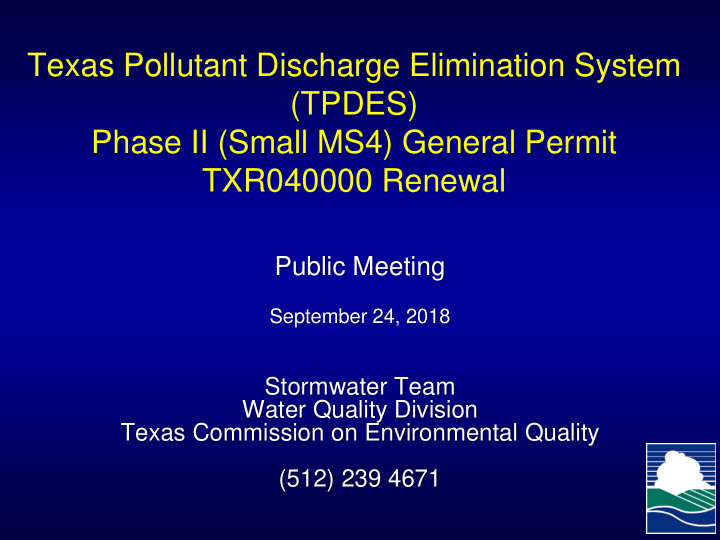



Texas Pollutant Discharge Elimination System (TPDES) Phase II (Small MS4) General Permit TXR040000 Renewal Public Meeting September 24, 2018 Stormwater Team Water Quality Division Texas Commission on Environmental Quality (512) 239 4671
Overview ➢ Renewal update and timeline ➢ Federal regulations affecting the general permit renewal ➢ Proposed changes to general permit
Phase II MS4 General Permit TXR040000 ➢ Regulates stormwater discharges from small MS4s located in urbanized areas (UAs) as defined by the 2000 and 2010 U.S. Censuses ➢ Effective: December 13, 2013 ➢ Expires: December 13, 2018 ➢ Universe • 506 Notices of Intent (NOIs) • 79 Waivers
Phase II MS4 General Permit, TXR04000 2018 Renewal ➢ Renewal process began: Feb. 2017 ➢ Stakeholder meeting: March 21, 2017 ➢ Development of draft permit: April through August 2017 ➢ Draft permit sent to EPA: August 29, 2017 ➢ EPA review: Fall of 2017 ➢ EPA objection letter: Dec. 4, 2017 ➢ EPA and TCEQ discussions: Dec. through August 2018 ➢ Response sent to EPA: June 20, 2018 ➢ EPA approval letter: July 31, 2018
Small MS4 General Permit, TXR04000 2018 Renewal ➢ Publish notice: Aug. 24, 2018 ➢ Texas Register ➢ 14 newspapers across the state ➢ 30-Day comment period: Aug. 24 – Sept. 24, 2018 ➢ Public meeting: Sept. 24, 2018 ➢ Commissioners Agenda ( tentative ): Dec. 12, 2018
New NPDES Rules – Phase II MS4 Remand Rule 40 CFR §§122.33 and 122.34 ➢ Phase II MS4 Remand Rule ➢ Published in Fed. Reg . on Dec. 9, 2016 ➢ Effective Jan. 9, 2017 ➢ The MS4 regulations are revised to ensure that: • States determine the adequacy of best management practices (BMPs) and permit requirements • States provide public notice and opportunity for the public to request a public hearing • Permits must be written with terms that are “clear, specific, and measurable”
New NPDES Rules – Phase II MS4 Remand Rule 40 CFR §§122.33 and 122.34 ➢ This is a procedural rule – no substantive changes are made to the Phase II MS4 requirements ➢ Includes two options for states to administer their Phase II MS4 programs • Option 1: Comprehensive general permit approach • The general permit needs to include all requirements necessary to meet the MS4 permit standard “to reduce pollutants to the maximum extent practicable” (MEP). • Option 2: Two-step General Permit • The general permit includes some requirements for all MS4s. • The state establishes additional requirements and BMPs for individual MS4s in the stormwater management programs (SWMPs).
New Federal Rules – Electronic Reporting Rule 40 CFR Part 127 ➢ Electronic Reporting Rule – effective Dec. 21, 2015 • Requires electronic submittal of applications and reports • Phase 2 of Rule: General permit applications (NOIs) and MS4 reports need to be submitted electronically by Dec. 21, 2020 • Appendix A of 40 CFR Part 127 includes a list of data elements that need to be reported electronically • Waiver option is available from eReporting – religious beliefs, no internet access, or training needed
Summary of Proposed Changes to Existing Permit ➢ Phase II MS4 Remand Rule • Modified permit language to be clear, specific and measurable • Added language regarding SWMP modifications during the permit term to comply with permit modification regulations at 40 CFR §§122.62 or 122.63 ➢ Electronic Reporting Rule • Electronic submittal of applications and reports by December 21, 2020
Summary of Proposed Changes to Existing Permit ➢ Modifications to the SWMP during the Permit Term List of changes that do not require a Notice of Change (NOC) • Non-substantial changes • Adding or annexing new areas • Adding BMPs • • List of changes that require an NOC Replacing BMPs • More frequent reporting or monitoring by the MS4 • Change to compliance dates – not more than 120 days • List of changes that require an NOC and public notice • • All other modifications that change the MS4s permit terms and conditions ➢ The public notice will be posted on the MS4’s website or the TCEQ website, if the MS4 does not have one.
Summary of Proposed Changes to Existing Permit ➢ Added and revised definitions such as benchmark value, infeasible, construction activity, Waters of the US, and impaired waterbodies ➢ Clarified that annexation of lands or acquiring new areas – will not require an NOC, but will require: Within 90 days have a plan for implementing the SWMP in new • areas Implement program in new areas as expeditiously as practicable • but no later than three years ➢ Added a requirement to check annually if a water body within the MS4’s permitted area has been added to the latest CWA 305(b)/303(d) list. Newly listed impaired waterbodies must be addressed in the • SWMP within two years.
Summary of Proposed Changes to Existing Permit ➢ Added a requirement to review and update the SWMP once a year in conjunction with completion of the annual report ➢ Added a requirement to publish the SWMP and annual reports on MS4’s website – if MS4 has one For Level 4 MS4s only: ➢ MCM 2. Illicit Discharge Detection and Elimination Add a program to control the discharge of floatables into the MS4 • ➢ MCM 5. Pollution Prevention and Good Housekeeping for Municipal Operations Add a program to evaluate new and existing flood • management projects for their water quality impact
Summary of Proposed Changes to Existing Permit ➢ MCM 7. Construction Activities where the MS4 is the site operator Decreased the benchmark value of total suspended solids from • 100 mg/L to 50 mg/L to be consistent with the 2016 MSGP ➢ Application fee increased from $100 to $400
TPDES Stormwater Program Contacts ➢ Water Quality Division • Stormwater Team • Rebecca L. Villalba, Team Leader • Lindsay Garza, Work Leader • Hanne Lehman Nielsen • Dan Siebeneicher • Gordon Cooper • Lili Martinez • Austin Office: (512) 239-4671
Recommend
More recommend